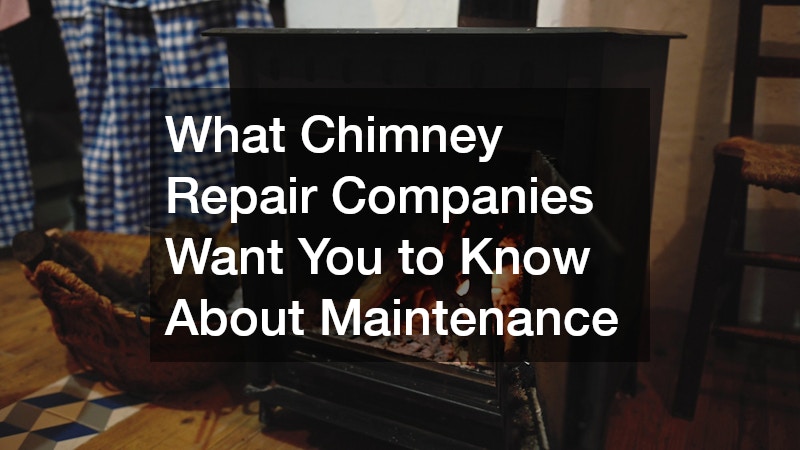Chimney maintenance is a crucial aspect of home safety and efficiency that often goes overlooked. Understanding the essentials of chimney care can prevent costly repairs and ensure the safety of your home. This article will explore what chimney repair companies wish you knew about maintaining your chimney, with a detailed look at the most common questions homeowners have.
Understanding the Risks of Neglect
Neglecting regular chimney inspections can lead to significant hazards, including increased fire risks due to the buildup of creosote, a highly flammable substance. Over time, the structural integrity of your chimney can deteriorate without proper care, potentially leading to costly repairs or even structural damage to your home.
Regular inspections help identify these issues early, providing peace of mind and protecting your investment in your property.
Chimney fires are more common than many homeowners realize. These fires can cause significant damage to the structure of your home and pose a serious threat to the safety of its occupants. By scheduling routine inspections, you can mitigate these risks and ensure that your chimney is functioning safely.
What Inspections Cover
A comprehensive chimney inspection involves a thorough examination of all accessible areas of the chimney’s interior and exterior structures. This includes the verification of chimney and venting systems’ clearance from combustibles and checks for any blockages or creosote deposits. By addressing issues such as these, inspections help prevent future damage that could lead to expensive repairs.
The inspection process also assesses the condition of the chimney liner. A damaged liner can allow heat and flue gases to escape, which can be dangerous and decrease efficiency. Professionals will often use specialized video equipment to accurately inspect the liner and diagnose any potential problem areas.
Recommended Inspection Frequency
It is generally recommended that homeowners have their chimneys inspected at least once a year, even if they are not used frequently. Regular checks are crucial for maintaining both safety and efficiency, as creosote can build up remarkably fast, especially if wood is a primary source of fuel. Additionally, unforeseen damage from environmental factors, such as severe weather, can occur at any time, making annual inspections a wise investment.
For households that use their fireplaces more regularly, such as during the colder months, or rely heavily on wood-burning appliances, more frequent inspections might be necessary. It’s advisable to consult with a chimney professional to tailor an inspection schedule based on the specific usage and condition of your chimney. This proactive approach can help catch problems early before they develop into serious hazards.
Identifying Common Issues
One of the most common chimney problems is creosote buildup, which is a natural byproduct of burning wood. Excessive creosote can ignite, leading to dangerous chimney fires which emphasize why regular cleaning is essential. Another frequent issue is cracked or deteriorating flue liners, which can compromise the chimney’s ability to contain and safely vent combustion gases.
Chimney leaks are also a prevalent concern among homeowners. Leaks can result from damaged flashing, missing chimney caps, or water-absorbent masonry that has been exposed to harsh weather conditions. Addressing these issues promptly with repairs or replacements can prevent further structural problems and expensive repairs.
Impact of Seasonal Changes
Chimneys must endure a range of seasonal weather conditions which can significantly influence their structural integrity. Winter’s freezing temperatures can create ice dams which may lead to cracks in the masonry or flue liner. The summer heat can similarly cause expansion and contraction in the materials used, potentially compromising the chimney’s structural soundness.
Spring’s humidity may aggravate existing structural issues, encouraging moss growth and contributing to the erosion of mortar joints. These climatic changes highlight the importance of regularly inspecting and maintaining chimneys to prevent weather-induced damage. Seasonal inspections ensure that homeowners can enjoy a problem-free fireplace, regardless of the time of year.
Protective Measures Against Weather
Implementing protective measures can safeguard chimneys from various weather conditions that threaten their structure and functionality. Flashing, which seals the joints between the roof and chimney, plays a crucial role in preventing leaks, especially during heavy rain. Ensuring that flashing is intact and free of rust or warping greatly protects against water intrusion.
Additionally, chimney caps are invaluable as they prevent precipitation, debris, and animals from entering the chimney. Rain, snow, and debris intake can cause significant damage which can be relatively easy to avoid with the use of a suitable cap. Regularly inspecting and maintaining chimney caps can prevent entry of elements that undermine safety and functionality.
Importance of Timely Weatherproofing
Weatherproofing should never be postponed, as delaying these measures can lead to accelerated deterioration of chimney parts and potentially expensive repairs. Applying protective coatings before harsh seasonal changes ensures that the chimney materials are reinforced and preserved against adverse weather. Proactively waterproofing provides long-term savings by avoiding costly emergency repairs down the line.
In summary, regular maintenance and timely inspections are key to ensuring the safety, efficiency, and longevity of your chimney. By understanding the importance of these practices, homeowners can take proactive steps to prevent problems and address issues before they become major concerns. Remember, taking the time to maintain your chimney can save you money and protect your home in the long run.
.

